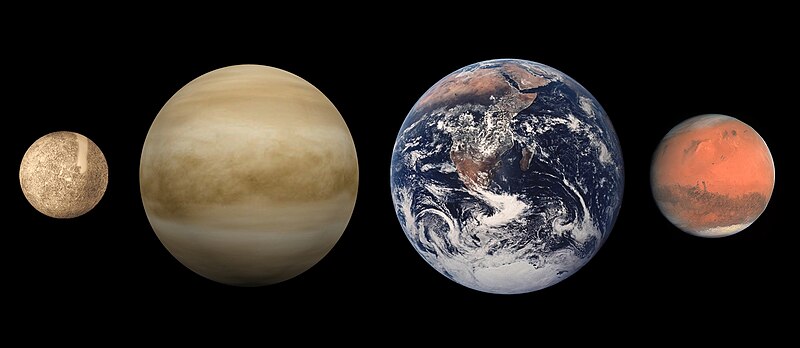ಫೈಲ್:Terrestrial planet size comparisons.jpg
ಗೋಚರೊ

ಈ ಮುನ್ನೋಟದ ಗಾತ್ರೊ: ೮೦೦ × ೩೪೮ ಚಿತ್ರೊ ಬಿಂದುಲು. ಬೇತೆಪಟೊತ್ತ ಗಾತ್ರೊ: ೩೨೦ × ೧೩೯ ಚಿತ್ರೊ ಬಿಂದುಲು | ೬೪೦ × ೨೭೯ ಚಿತ್ರೊ ಬಿಂದುಲು | ೧,೫೦೦ × ೬೫೩ ಚಿತ್ರೊ ಬಿಂದುಲು.
ಮೂಲೊ ಫೈಲ್ (೧,೫೦೦ × ೬೫೩ ಚಿತ್ರಬಿಂದುಲು, ಫೈಲ್ದ ಗಾತ್ರೊ: ೩೧೪ KB, MIME ಪ್ರಕಾರೊ: image/jpeg)
ಫೈಲ್ದ ಇತಿಹಾಸೊ
ದಿನೊ/ಪೊರ್ತುದ ಮಿತ್ತ್ ಒತ್ತ್ಂಡ ಫೈಲ್ ಆ ಪೊರ್ತುಡು ಎಂಚ ತೋಜೊಂದಿತ್ತ್ಂಡ್ ಪಂದ್ ತೂವೊಲಿ.
| ದಿನೊ/ಪೊರ್ತು | ಎಲ್ಯಚಿತ್ರೊ | ಆಯಾಮೊಲು | ಬಳಕೆದಾರೆರ್ | ಅಬಿಪ್ರಾಯೊ | |
|---|---|---|---|---|---|
| ಇತ್ತೆದ | ೦೨:೦೯, ೫ ದಸಂಬರ್ ೨೦೧೮ |  | ೧,೫೦೦ × ೬೫೩ (೩೧೪ KB) | Allice Hunter | Correcting Mars |
| ೨೨:೫೧, ೩ ದಸಂಬರ್ ೨೦೧೮ |  | ೧,೫೦೦ × ೬೫೩ (೩೧೫ KB) | Allice Hunter | updated: correcting the color of Mars. Based on image of Mars >> File:OSIRIS Mars true color.jpg. There was no distortion in size | |
| ೦೪:೦೭, ೧೬ ಜುಲಾಯಿ ೨೦೧೨ |  | ೧,೫೦೦ × ೬೫೩ (೨೭೬ KB) | Ubiquinoid | updated: correcting for apparent undersizing of Venus (from 90 to 95% (true) of Earth's diameter) - based on image of Venus w/NASA cloup map (resized) at http://cronodon.com/PlanetTech/Venus.html; centred | |
| ೨೦:೨೨, ೧೫ ಜುಲಾಯಿ ೨೦೧೨ |  | ೧,೫೦೦ × ೬೫೩ (೭೯ KB) | Ubiquinoid | updated: correcting for apparent undersizing of Venus (95% of Earth's diameter) - based on image of Venus w/cloup map (resized) at http://cronodon.com/PlanetTech/Venus.html | |
| ೦೫:೨೦, ೨೮ ದಸಂಬರ್ ೨೦೦೭ |  | ೧,೫೦೦ × ೬೫೩ (೪೫೬ KB) | Crotalus horridus~commonswiki | Created identical and more compact version using the "Huffman optimized" feature of jpegcrop. Nothing else has been changed. | |
| ೦೪:೫೭, ೧೫ ಜೂನ್ ೨೦೦೬ |  | ೧,೫೦೦ × ೬೫೩ (೪೮೮ KB) | Nicke L | {{Information| |Description= The inner planets, from left to right: en:Mercury, en:Venus, en:Earth, and en:Mars Source: http://solarsystem.nasa.gov/multimedia/gallery/terr_sizes.jpg |Source= |Date= |Author=User [[:en:User:Brian0918|Br |
ಫೈಲ್ದ ಉಪಯೋಗ
ಈ ಫೈಲ್ಗ್ ಸಂಪರ್ಕೊ ಉಪ್ಪುನ ವಾ ಪುಟೊಲಾ ಇಜ್ಜಿ.
ಈ ಫೈಲ್ ಒಲ್ಪ ಮಾತ ಗಲಸ್ದೆರ್
ಈ ಫೈಲ್ನ್ ತಿರ್ತ್ ಉಪ್ಪುನ ಬೇತೆ ವಿಕಿಲು ಗಲಸುವ:
- af.wikipedia.org ಮಿತ್ತ್ ಉಪಯೋಗೊ
- arz.wikipedia.org ಮಿತ್ತ್ ಉಪಯೋಗೊ
- az.wikipedia.org ಮಿತ್ತ್ ಉಪಯೋಗೊ
- bat-smg.wikipedia.org ಮಿತ್ತ್ ಉಪಯೋಗೊ
- ba.wikipedia.org ಮಿತ್ತ್ ಉಪಯೋಗೊ
- be-tarask.wikipedia.org ಮಿತ್ತ್ ಉಪಯೋಗೊ
- beta.wikiversity.org ಮಿತ್ತ್ ಉಪಯೋಗೊ
- be.wikipedia.org ಮಿತ್ತ್ ಉಪಯೋಗೊ
- bxr.wikipedia.org ಮಿತ್ತ್ ಉಪಯೋಗೊ
- ca.wikipedia.org ಮಿತ್ತ್ ಉಪಯೋಗೊ
- cv.wikipedia.org ಮಿತ್ತ್ ಉಪಯೋಗೊ
- da.wikipedia.org ಮಿತ್ತ್ ಉಪಯೋಗೊ
- da.wikisource.org ಮಿತ್ತ್ ಉಪಯೋಗೊ
- de.wikipedia.org ಮಿತ್ತ್ ಉಪಯೋಗೊ
- de.wikisource.org ಮಿತ್ತ್ ಉಪಯೋಗೊ
- de.wikiversity.org ಮಿತ್ತ್ ಉಪಯೋಗೊ
- en.wikipedia.org ಮಿತ್ತ್ ಉಪಯೋಗೊ
- User:Can't sleep, clown will eat me
- User:Newone
- Wikipedia:Featured picture candidates/Terrestrial planet size comparisons
- Wikipedia:Featured picture candidates/May-2006
- Talk:Dwarf planet/Archive 1
- Wikipedia:Featured picture candidates/February-2007
- Wikipedia:Featured picture candidates/Terrestrial planets
- User:Can't sleep, clown will eat me/User/appetizers
- Wikipedia:Featured picture candidates/August-2007
- Wikipedia:Featured picture candidates/Terrestrial planet size comparisons.jpg
- User:Mitternacht90/EarthandSpace
- User:HarryAlffa/Solar System synopsis
- Talk:Solar System/Archive 5
- User:Physchim62/Planetmass
ಈ ಫೈಲ್ದ ನನಾತ್ ಜಾಗತಿಕ ಉಪಯೋಗೊನು ತೂಲೆ.


